Remnants of ancient walls covered by brambles and shrubs, and then the cliff overhanging the Nera River. What could be beyond those crumbling stones of the monastery? What secrets did the coenoby of san Domenico, now partly abandoned and buried by the cowardly bombardments of the war, still conceal, and which ones Narni underground? A rope thrown in mid-air, anchored to the wall of San Bernardo’s gardens, a helmet on the head and off down into the unknown: in 1979, six young men improvised to be explorers. We know that adventures are better than boredom.
The discovery of Narni Underground
Can you imagine Mr Ernani Proietti’s astonishment at seeing those young boys suddenly get into his garden? So, this is what they saw after climbed over the cliff: Mr Ernani and the land he owned! We could almost figure him, the elderly farmer, taking his stick and, threateningly, pointing it towards the unfortunates whom had trampled on his vegetables. The boys, including a young Roberto Nini1, with fear began stammering sentences full of apologies and justifications, after all it was just a noble exploration for speleological purposes. Speleology! They had to struggle to explain what it was all about, what was that pastime which led young people going into dark and damp recesses.
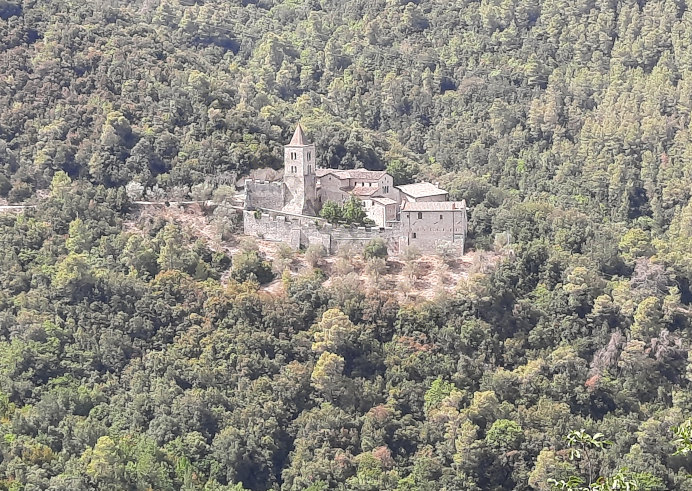
Then it happened, everything began, as the timing of events was propitious. Mr Ernani revealed to the six young people that, in the steep slope that plunged gracelessly into the valley, there was an opening, a window through which the rock breathed. Who knows what it could contain, perhaps a treasure… The fissure was narrow but with a little effort it could be widened, with ingenuity it could be crossed: without a moment’s thought they plunged into the darkness like the fire of a candle without a wick.
Narni Underground and the mysterious crypt
The six young men entered a suspiciously large room. Water dripped over their heads, ticking, and beyond the stratified limestone on the walls were traces of mysterious frescoes, eyes peering into the unfathomable. What that strange crypt was, no one in Narni knew, or even imagined. The boys immediately felt they had made a sensational discovery. Hence, they decided to found the Gruppo Speleologico Narnense (“Narni Speleological Group”) to explore and clean up that underground space, struggling hard to obtain permits from the municipality. What they could not imagine was that this was only the beginning of a long adventure.
Now Roberto Nini is president of the Association “Narni Underground”. That place he discovered in 1979 was a 12th-13th century church. The building had been completely forgotten, it certainly belonged to the monastery of San Domenico, although not the same known at the time. Even before the Dominicans arrived there, in fact, there had been an earlier cult complex, called Santa Maria Maggiore2.
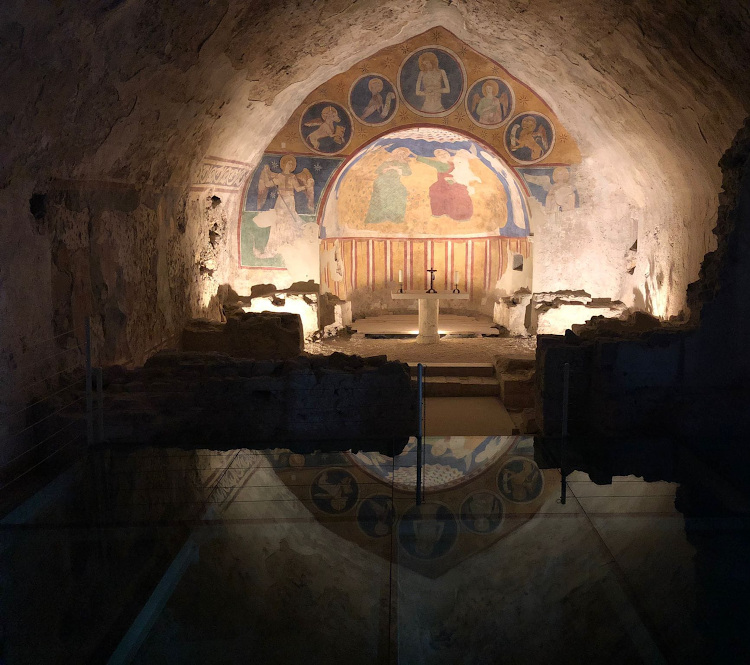
The frescoes of Narni Underground
In particular, that church was decorated with frescoes by unknown artists of the Umbrian school. So, it was necessary to remove the soil, peel and restore the walls, and rediscover the colours with their ancient splendour. Many of the funds were contributed by the visitors themselves – the Narni Underground association inaugurated the visit tour in 1994 – who were enthusiastic about being part of this project.
With the first restorations in the year 2000, the 13th-14th century paintings of the presbytery were found: a Coronation of the Virgin, and on the apsidal arch, a series of clipei depicting Christ with the four Evangelists. Just below, two majestic figures of St. Michael the Archangel emerged from the limestone: on the left as commander of the Celestial Militia and sauroctonos, the one who kills the Dragon; on the right as a psychagogue, weigher of souls in the psychostasy. The vault of the church was instead frescoed with a marvellous starry sky, a figurative reference to the crown that adorns the Virgin’s head in Holy Scripture3.
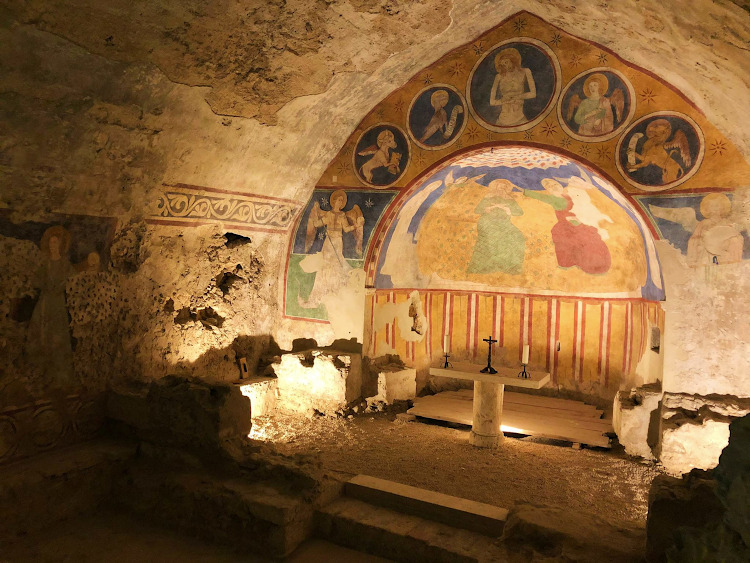
Dedication to St. Michael the Archangel
The religious building was therefore dedicated to St. Michael. It is no a coincidence that the hypogeum, dug into the rock, represents the sanctuary of the Archangel par excellence. The church in Narni was built ad instar Gargani, following the example of the cave of St. Michael in Monte Sant’Angelo, from where the cult had spread throughout Europe. Legend says that there is a sacred line connecting the main places dedicated to St. Michael: from Mont Saint-Michel in France, passing through the Abbey in Susa Valley and the Sanctuary on Mount Gargano, to the Monastery of Mount Carmel. Well, the church of Narni is also located on this route.
All this was not yet known when, in 2000, the church was reconsecrated with the name of Santa Maria della Rupe, due to its impervious location. Moreover, a relevant fact for tracing the origin of that mysterious place of prayer, archaeologists conducted some stratigraphic investigations on the ground floor, now visible through a plexiglass, and it was discovered that there were more ancient structures beneath it. For instance, a Roman cistern from ancient Narnia was found, possibly belonging to a domus, and a little further on, the lost remains of the Formina aqueduct, built by Tiberius in 27 AD.
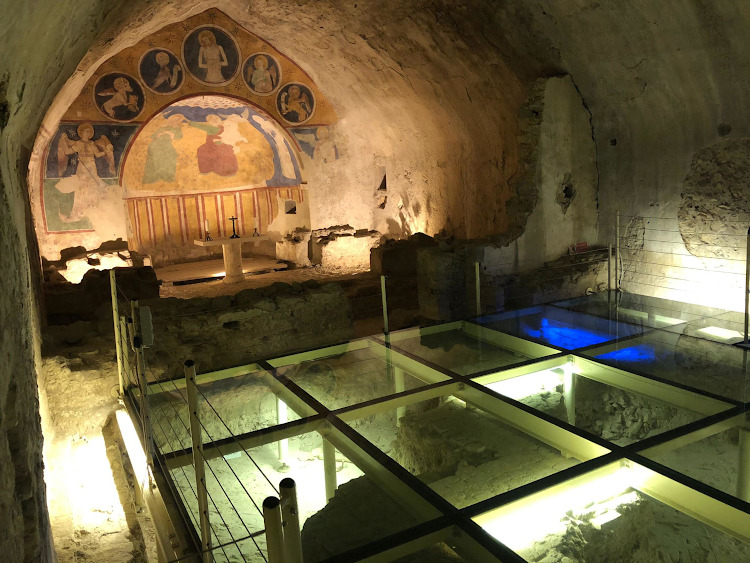
The secret rooms of Narni Underground
The six boys had found any treasure, but it was of little importance: at least their thirst for adventure was satisfied. Nonetheless, the discovery of the underground church had plunged them into an unknown and exciting world of tunnels and hidden, mysterious rooms. There was a path, an ancient gallery. Here they were again, moving forward with the flickering light of torches, back in 1979; one step after another, and a shiver down their spine.
Suddenly the boys saw something: they noticed an irregularity on the wall, as if it were an obstacle. A walled-up door! At the knock on the bricks, the noise was dull, as if there was an empty space on the other side. In fact, the wall seemed to be hiding a jamb: once upon a time, a room opened from that door, but the boys found it barred, inaccessible. Could it be that another mystery was kept within those walls, a secret that someone had wanted to hide?
The “gang of the hole“
The boys thought, without hesitation, of removing the section of wall that obstructed the passage. But there was a big problem: the room was located next to the house of Alberto and Rosita, who did not agree at all, fearing a structural collapse. Should it be given up then? Never. After all, it was only a matter of patient waiting: when the parade of the city (“Corsa all’Anello”) took place on Saturday evening, the neighbours left their dwellings and all the citizens went to the event; all except Roberto Nini and the guys of Narni Underground. It was time to action, the famous “gang of the hole” could wait no longer! The youths had secretly gone to the mysterious door and, since no one could hear them, they began with great noise to hit the wall with a hammer.
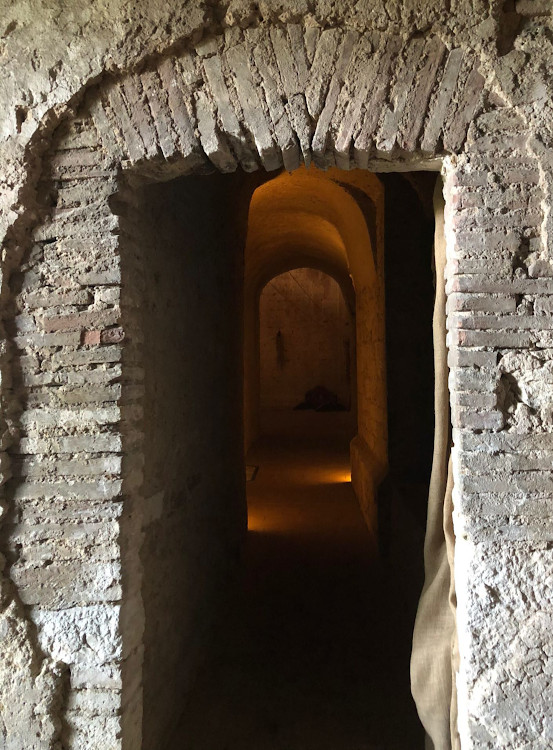
One shot and another until a large hole was formed, and was possibile to see what was behind it. There was another corridor and finally a series of strange rooms, with graffiti on the walls, that looked like prisons. An idea flashed through the young people’s heads, bizarre certainly but not impossible. They just had to connect the pieces of the mosaic: a Dominican convent, a hidden prison and strange graffiti. Could it be possible that Narni hosted the Holy Office, of the dreaded Roman Inquisition?
The bigamist
Once again, however, everything seemed forgotten, scattered, even absurd. How could the Holy Inquisition existed in Narni if in no document, in no source was there any mention of it? The question remained unresolved for a long time, at least until Providence manifested itself, actually like so many other times in this incredible history. During the visits to Narni Underground, an official of the Vatican Secret Archives, an ambassador of the Holy See, then even a bishop arrived: the doors of the archives of the Inquisition were opened wide, time after time. And there, among those papers yellowed by time, was the history of the tribunal of the Holy Office in Narni.
In the Dominican monastery, the Inquisition had really existed, but for some unknown reason everything had been deleted, the doors bricked up and all the documents burned… Almost, because something was miraculously saved. The reports from the Vatican Archives referred to a certain Domenico Ciabocchi who had been imprisoned in Narni by the Inquisition4. It was only a few lines, but enough to reveal that the same prisoner was mentioned in some documents of the Trinity College in Dublin5. Surprisingly, in those papers was the whole story of the process against Domenico Ciabocchi.
The “room of torment”
It was thus discovered that the man had been imprisoned a first time by the Holy Office as a bigamist. This was a serious accusation, a sacramental violation, because the man had married two different women. Most importantly, in 1726, Ciabocchi had committed murder; he had, in fact, strangled the guard who brought him lunch with a rope and managed to escape from the prison cell. All this had happened inside the room that Roberto Nini and the other boys had rediscovered. That room was called in the Dublin documents as the “chamber of torment”.
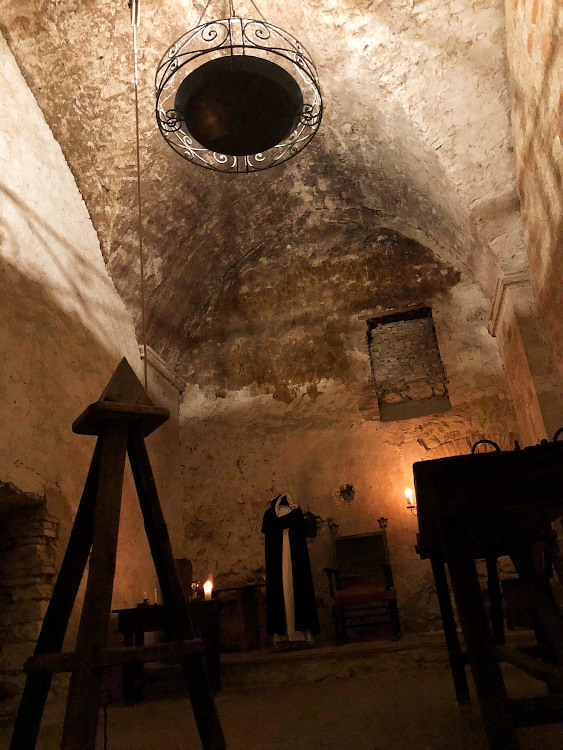
This was the place of torture, where a rope was used to force the prisoners to the terrible strappado. The room was directly connected to two cells on the ground floor. One of them was used for a harsh prison regime, as evidenced by the numerous graffiti carved by prisoners on the walls. Another room was located upstairs, near the Inquisitor’s flat6. Finally, the documents of the process reveal that the bigamist Domenico Ciabocchi was captured because of a letter sent to his second wife. Ah, love! Once again locked up, chained in the prison of the Holy Office in Narni, and condemned to row for the rest of his life.
Lombardini and the symbols of Freemasonry
Among those imprisoned in Narni by the Holy Office, Giuseppe Andrea Lombardini was not a common criminal. Sources attest that he was a corporal of the Inquisition and served at the Spoleto headquarters, on which Narni Vicariate also depended7. For reasons that have never been clarified, however, he was accused of treason as he was guilty of aiding the attempted escape of a prisoner8.
Nevertheless, Lombardini never pleaded guilty and ever since his imprisonment on 4 December 1759, he continued to claim he was a victim of conspiracy. On the plaster of one of the prison walls, next to his name, he wrote in clear letters the word “innocent”, today only readable with grazing light because someone erased it; most probably the Dominican prison guards.
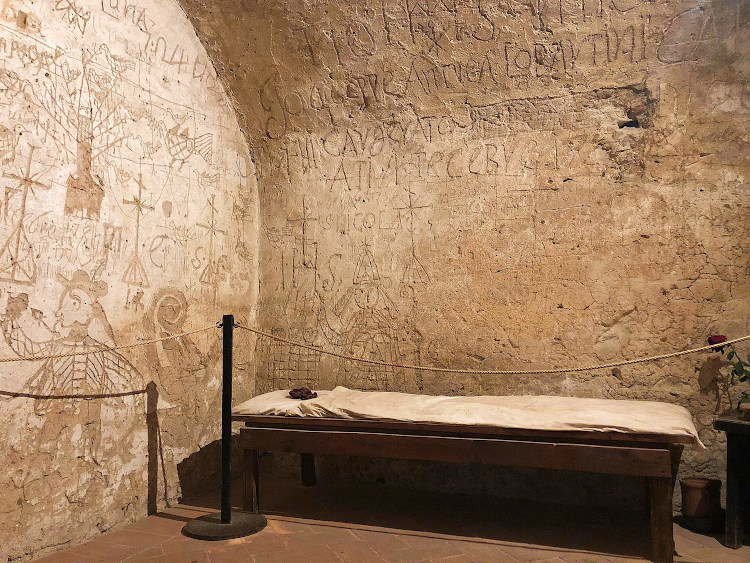
The prisoner then realised that it was not convenient to write his messages so explicitly, rather he had to conceal them, to make them hidden through symbols, so only those who were initiated could read them. From that moment on, Lombardini used the complex language of Freemasonry to engrave almost all the plastered wall portions of his prison cell. Mysterious graffiti of all kinds, numerologies, christograms and figures of saints, were shown to the Dominicans as simple Christian testimonies. Yet, behind the appearances, they concealed darker meanings, double readings and esoteric interpretations.
The manifest meaning
Lombardini was a corporal in the guards of the Holy Office, but he was also secretly a Freemason. Is it possible that someone had discovered this? Was he imprisoned for this reason under some pretext? The prisoner’s bitterness was particularly against the Dominicans. For example, he carefully avoided writing the letter ‘D’ in his wall messages, as a sign of contempt towards the Order. Thus we read “Il Paratiso Santo”, “Tio mio” and even his name is written as “Giuseppe Antrea Lobartini”. Lombardini wanted to leave a message for his successors, he wanted to make manifest the injustice to which he was subjected.
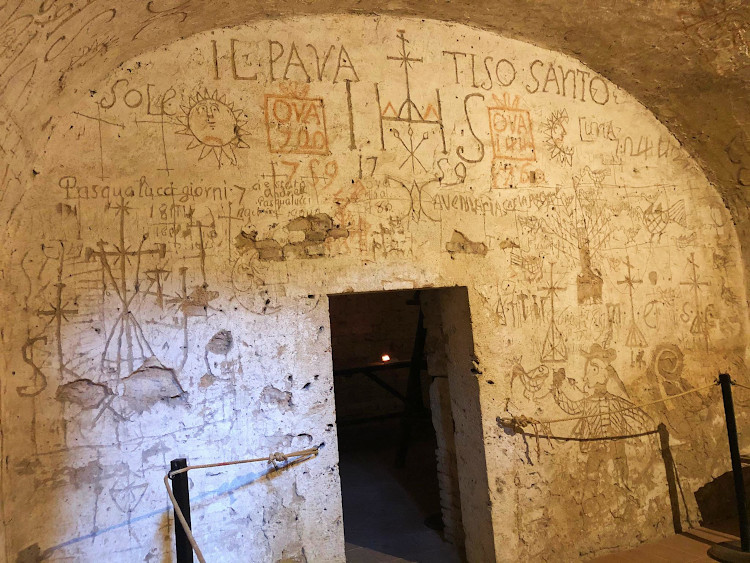
Thus, on each wall, he wrote the monogram of Saint Bernardine IHS surmounted by a cross. Accompanying it were the three nails of the Passion: this was the canonical representation of the symbol among the Jesuits, an order that in those years suffered an unjustified persecution, until its suppression in 1773. It is clear that Lombardini empathised with this painful situation; in his vision, a corrupt part of the Church oppressed the righteous. Some doves, symbols of peace, are in fact chained to the tree of life and, just below, a falconer threatens to release his bird. The IHS monogram on the entrance wall was mirrored, in keeping with Masonic tradition, by the inverted one on the ceiling vault. Even the figures of the year of imprisonment, 1759, were written backwards and, thus read, turned into the inscription “exit”.
Time of imprisonment and passion
The representations of the sun and moon expressed the beginning and waiting for the end of the imprisonment. The symbols were flanked by the inscriptions “720 HOUR, 1759” and “1440 HOUR, 1760”, indicating the time Lombardini spent in his prison cell by means of a time-calculation. This concept was echoed by the sundial inscribed near a window. The idea of unjust persecution was manifested by different symbolic motifs. Hence, it is not difficult to imagine that he compared himself to Christ: the image of a rooster refers to betrayal, while fourteen crosses depict the Stations of the Cross. St. Nicholas is depicted in the act of freeing the three officers unjustly imprisoned by Constantine.
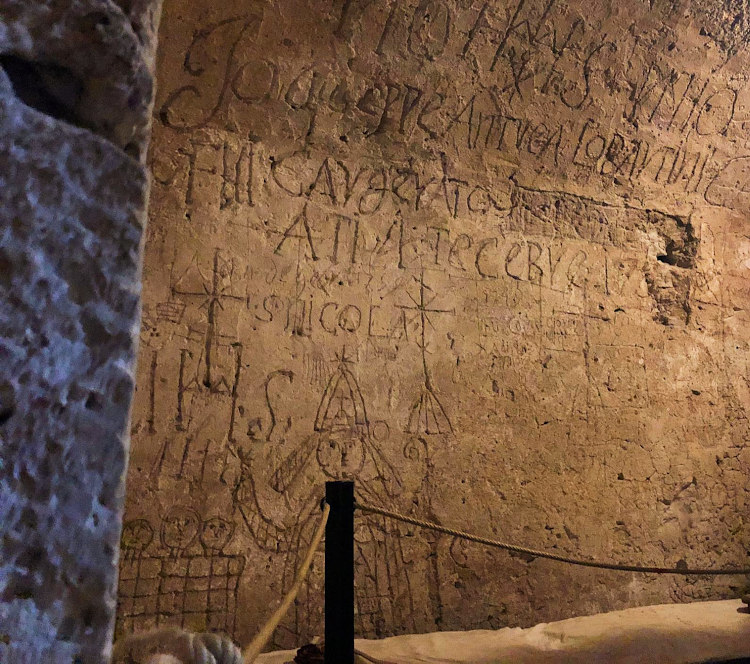
The esoteric meaning and the Masonic Temple
However, when reading the inscriptions left by Andrea Lombardini, we should not just focus on first considerations, but try to look further. It was discovered that the prisoner of Narni had transformed his prison cell into a Masonic temple, given the symbolism. In the Marian sign he hid the square and compass, while in the monogram of St. Bernardino we glimpse the Delta, the scrutinising eye of the Great Architect of the Universe. The palindromic sequence 7244270 that Lombardini engraved several times on the plaster probably also refers to it9. The sun and the moon, in Masonic symbolism, are instead associated with the columns of the Temple of Solomon, Joachim and Boaz, as figuration of opposing principles: day and night, hot and cold, dry and wet, life and death, good and evil.
Instead of a “D”, the prisoner used a “T” similar to a tau: a sign that refers to the cross and a seal belonging to the Worshipful Master of the Lodge. Again, Masonic esotericism is present in the recurrence of the number seven, which is realised through the union of three, the divine dimension, with the four elements of matter. Thus it appears in the prison that houses the officers freed by St. Nicholas and in the steps of Jacob’s Ladder.
Sentence and pardon
Thanks to the archives of the Congregation for the Doctrine of the Faith, it is possible to reconstruct the events that followed Andrea Lombardini’s imprisonment10. We thus discover that although he declared himself innocent, the Inquisition tribunal condemned him to public ridicule and exile. The decrees of the Holy Office reveal that the sentence was handed down on 30 January 1760. The prisoner was then transferred to Spoleto, after spending around sixty days in Narni. Finally, we know that he was pardoned by a decree on 28 December 176311. However, Lombardini had been severely tormented by imprisonment, torture, inner torment and finally exile. He had perhaps become a different man from the one who, three years earlier, had transformed a bare prison cell into a mysterious and esoteric temple.
Samuele Corrente Naso
Map of places
Notes
- The other boys were Marco Bartolini, Massimo Frezza, Mauro Mazzoli, Mauro Montini and Giovanni Nini. ↩︎
- C. Longo, Agli inizi dell’insediamento domenicano a Narni, in Atti del Convegno “La chiesa di S. Maria Maggiore e i Domenicani a Narni”, Narni 29/30 Settembre 2006. The author reports the existence of a document from 1304 attesting to the donation of the Santa Maria Maggiore complex to the Dominicans by Benedict XI at the end of the 13th century. ↩︎
- Book of Revelation 12. ↩︎
- Archive of the Congregation for the Doctrine of the Faith, former Holy Office. ↩︎
- R. Nini, Alla ricerca della verità – Sulle tracce dell’Inquisizione per scoprire il mistero dei sotterranei di Narni, Arrone (Tr), 2009. ↩︎
- R. Nini, Il Sant’Uffizio di Narni, dagli Atti dei convegni dell’Accademia dei Lincei “A dieci anni dall’apertura dell’archivio della congregazione per la dottrina della fede: storia e archivi dell’Inquisizione”, Roma, 21-23 febbraio 2008. ↩︎
- R. Nini, Una missione da compiere – I sotterranei dell’Inquisizione a Narni, Arrone (Tr), 2002. ↩︎
- This was the cop Pietro Milli, imprisoned in Spoleto for insulting the vicar of Piediluco. ↩︎
- A.G.D.G.A.D.U. stands for “To the Glory of the Great Architect of the Universe”. The letters correspond in frequency to the digits of the number sequence, made palindromic. ↩︎
- Decreta S.Offici, 1548-1769. ↩︎
- Ibidem note 6. ↩︎

